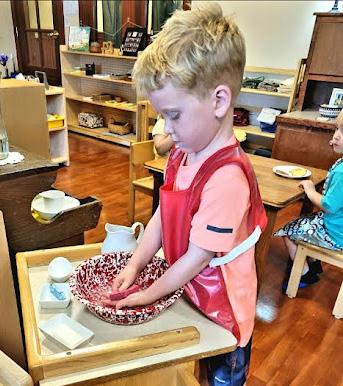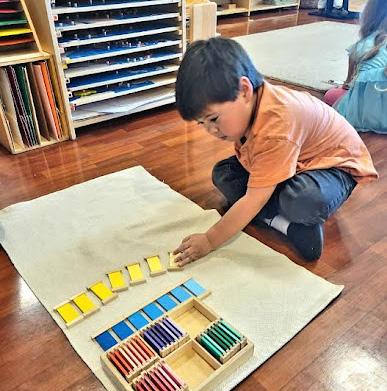
1 minute read
Absorbent Mind
exploration of their surroundings and the materials made available to them through touching, manipulating, and exploring. They begin to refine the skills they developed in the first three years such as control of movement and balance. Children are provided with many materials to explore such as: cutting with scissors (which will eventually be used for bigger works like flower arranging), wiping up a spill, zipping a coat or buttoning a sweater, polishing wood and metal, washing dishes, setting a table, window washing, and sink scrubbing, to name a few. Children are shown how to use these materials in a clear and consistent way. By choosing to practice these works, children will become masters of the movement; this leads to independence. They also consciously seek specific information like order, sequence, numbers, music, letter shapes/sounds. They are exposed to many math and language materials such as number rods (which associate quantities with written numbers), golden beads (which represents a unit, 10, 100, and 1000), the hundred board (which sequences numbers 1-100), sounds boxes, rhyming works, and the movable alphabet to build words and sentences. All of these materials are designed for the child to be able to touch, manipulate, and explore. These are all building blocks for the math, reading, and writing skills to come.

By April Coverstone, Primary 3 Teacher
We can observe, respect, accept, and try to understand the child the best that we can. However, we need to use these observations to adjust how we are with them as they pass through each plane. In order for teachers and parents to help support 3-6 year olds at school and at home, it is important to take the time to prepare an environment that allows for order, exploration of personal interests, allows them to work at their own pace, and leads them towards independence. An ordered environment means having a place for everything, so that children know where to find what they need and have a place to put it when they’re finished. It also means simplifying your home environment such as limiting toy choices and providing open shelves at eye level. Children also like to feel valued and helpful, so involve your child by letting them help prepare meals, organize shelves, wash tables, fold their own clothes, care for pets, etc. It is also our responsibility to model, model, model! We must model the behavior in which we wish our children to exhibit such as patience, kindness, openness, and staying positive. When providing opportunities and meeting each child at the developmental needs of each plane, it successfully allows for their natural patterns of development to be met academically, socially, and emotionally.









